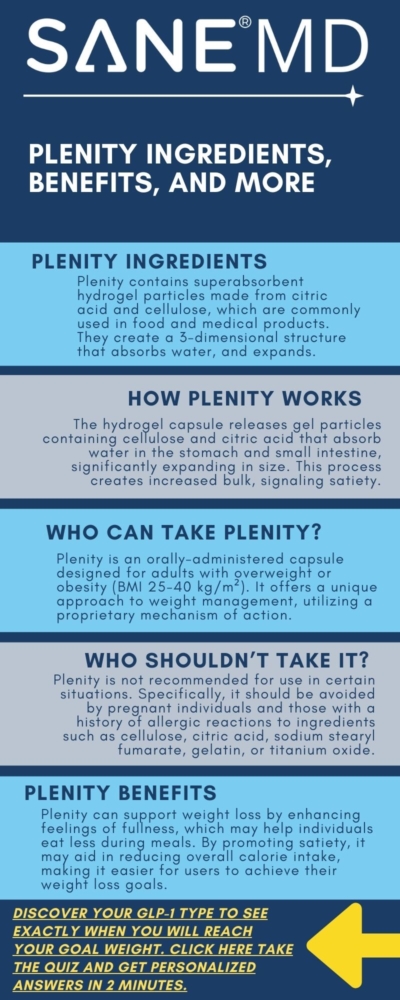Plenity Ingredients 2025
Dr. Matthew Olesiak, MD, is the Chief Medical Director at SANESolution, a renowned wellness technology company dedicated to providing evidence-based solutions for optimal living. Dr. Olesiak earned his medical degree from the prestigious Jagiellonian University Medical College in Kraków, Poland, where he developed a strong foundation in medicine.
Plenity is a novel non-systemic oral hydrogel designed to aid in weight management for overweight and obese adults. By promoting a feeling of fullness and reducing calorie intake, Plenity helps compatible individuals lose weight when combined with a healthy diet and regular exercise program.
The key to its effectiveness lies in the Plenity ingredients, which include naturally derived building blocks like cellulose and citric acid, and its innovative formulation. When compared to other weight loss drugs such as Plenity vs Ozempic for weight loss, Plenity proves to be a considerable option in the end.
Key Takeaways
- Plenity is a non-systemic weight loss aid that uses superabsorbent hydrogel technology to promote fullness without being absorbed into the bloodstream.
- Not suitable for everyone, including individuals with Crohn’s disease, suspected strictures, or those who are pregnant—consult a healthcare provider for guidance.
- Mild side effects like bloating or abdominal discomfort are common, but serious issues are rare and should be addressed immediately with medical attention.
What is Plenity?
Plenity is a weight loss option that offers a novel approach to weight management. Available only by prescription, it is designed to be used in conjunction with a healthy diet and regular exercise.
Plenity provides a comprehensive approach to weight loss by addressing both the physical and psychological factors involved in overeating.
This product offers a non-invasive and non-surgical option for those looking to make positive changes in their lives.
Key Plenity Ingredients and Their Functions
| Ingredient | Role in Plenity |
|---|---|
| Citric Acid | Forms the hydrogel structure that absorbs water and expands in the stomach. |
| Cellulose | A plant-based fiber that creates the hydrogel’s three-dimensional matrix. |
| Sodium Stearyl Fumarate | Ensures capsule stability and aids in formula |
Plenity Ingredients: What Are the Ingredients in Plenity?
Plenity is composed of superabsorbent hydrogel particles made from citric acid and cellulose, both of which are commonly used in food and medical products.
These ingredients create a three-dimensional structure that absorbs water and expands in the stomach, forming gel particles. These particles help increase a person’s stomach volume, making them feel full after consuming smaller amounts of food.
Key ingredients include:
- Citric Acid: A naturally occurring compound that plays a role in forming the hydrogel structure.
- Cellulose: A plant-based fiber that contributes to the hydrogel’s three-dimensional matrix.
- Sodium Stearyl Fumarate: An additive that aids in capsule formulation and ensures stability.
How Does Plenity Work?
Plenity capsules are taken before lunch and dinner, with water. Once ingested, the capsules disintegrate in the GI tract, releasing gel particles that mix with the consumed food. These particles expand, creating a larger volume in the stomach and promoting satiety.
This process reduces overall calorie intake, aiding in weight loss.
Benefits of Plenity
Plenity has been shown to have numerous benefits for individuals looking to lose weight and maintain a healthier lifestyle.
Some of the key benefits include:
- Significant weight loss: Plenity has been shown to help individuals lose weight and maintain weight loss over time.
- Reduced body mass index (BMI): Plenity has been shown to decrease BMI, which is a key indicator of overall health.
- Decreased belly fat: Plenity has been shown to reduce waist circumference, which is associated with inflammation and increased disease risk.
- Improved weight management: Plenity is designed to help certain individuals manage their weight and maintain weight loss over time.
Potential Disadvantages
While Plenity has several potential advantages, there are also some potential disadvantages to consider.
Some of the key disadvantages include:
- Limited availability: Plenity is only available by prescription and may not be widely available.
- Cost: Plenity may be more expensive than other weight loss options.
- Side effects: While Plenity is considered safe and well-tolerated, there may be some side effects, such as abdominal distension, flatulence, and diarrhea.
Clinical Trials and Weight Loss Effectiveness
Plenity’s effectiveness has been evaluated through multiple clinical trials, including the GLOW study and the GLOW EX study. In these studies, the treatment group compared to the placebo group showed significant differences in outcomes.
These placebo-controlled studies demonstrated significant differences between the treatment group and the placebo group, with participants in the treatment group experiencing greater reductions in body weight, waist circumference and improved glycemic control.
Key Findings:
- Participants in the treatment group lost an average of about one-fourth of their initial body weight over the study period.
- Minimal side effects were reported, with a low overall incidence of abdominal pain, abdominal distension, and other adverse events.
- The study highlighted the importance of combining Plenity with a reduced-calorie diet and regular exercise for optimal results.
- The clinical trials also evaluated weight regain, noting that a significant percentage of subjects maintained their initial weight loss, even when weight regain was anticipated after the initial weight loss period.
Potential Side Effects of Plenity, Including Severe Abdominal Pain
While Plenity is generally well-tolerated, some users may experience potential side effects, including:
- Abdominal distension
- Severe abdominal pain (rare)
- Changes in bowel movements
It’s crucial to consult a healthcare professional if any of these symptoms persist or worsen.
Additionally, individuals with suspected strictures, Crohn’s disease, or other gastrointestinal conditions should avoid using Plenity.
Serious Side Effects
Several serious side effects have been linked to Plenity usage, though they are rare. These include:
- Severe abdominal pain: In rare cases, Plenity may cause severe abdominal pain, which can be a sign of a more serious underlying condition.
- Allergic reactions: Some individuals may be allergic to Plenity, which can cause a range of symptoms, including hives, itching, and difficulty breathing.
Dosage and Timing
For Plenity, the suggested dosage is two capsules taken with water 20 to 30 minutes prior to lunch and dinner. It’s important to follow the dosage and timing instructions provided by your healthcare provider to achieve the best results.
Who Should Avoid Plenity? (Overweight and Obese Adults)
Plenity is not suitable for everyone. Individuals with the following medical conditions or concerns should not take Plenity:
- Crohn’s disease or other GI tract disorders
- Suspected strictures in the digestive tract
- Those requiring emergency surgery
Consult a healthcare provider to determine if Plenity is appropriate for you.
Comparing Plenity to Similar Products
While Plenity is unique, other weight management tools, such as prescription medications and surgical options, may also help individuals achieve their goals.
However, Plenity is a weight loss intervention that presents a distinct method for managing body weight.
Lifestyle Recommendations for Plenity Users on a Reduced Calorie Diet
For best results, Plenity should be combined with:
- A healthy diet that emphasizes legumes, lean proteins, and vegetables.
- Regular exercise, such as cardio and strength training.
- Consistent communication with a healthcare provider to monitor progress.
FAQs about Plenity
Is Plenity Being Discontinued?
Plenity is not being discontinued and remains widely available. It continues to be a frequently prescribed choice for compatible overweight and obese adults looking for a non-invasive weight loss solution.
Unlike traditional medications, Plenity uses superabsorbent hydrogel technology to promote a feeling of fullness without being absorbed into the bloodstream. This unique approach has made it a preferred option for many seeking a safe and effective weight management tool.
If you’re considering Plenity, it’s always a good idea to consult with a healthcare provider for guidance.
Who Cannot Take Plenity?
Plenity is not suitable for everyone, and certain individuals should avoid using it. Those with gastrointestinal conditions such as Crohn’s disease or suspected strictures, as well as individuals who are pregnant or planning to become pregnant, are advised not to take Plenity. These conditions could increase the risk of complications or reduce the product’s effectiveness.
Before starting any weight loss program, it’s essential to consult a healthcare provider to ensure it aligns with your specific health needs and medical history.
What Is Similar to Plenity?
Several weight loss products share similar goals but work through different mechanisms. Medications like Orlistat inhibit fat absorption, while GLP-1 receptor agonists such as Wegovy and Saxenda regulate appetite and blood sugar levels.
However, Plenity presents a distinct method for managing body weight. it uses superabsorbent hydrogel particles to create a feeling of fullness without systemic absorption. If you’re exploring weight loss options, understanding the benefits and potential side effects of each product can help you make an informed choice.
What Are the Side Effects of Plenity?
Plenity is generally well-tolerated, but like any medical product, it can cause side effects. Common side effects include bloating, abdominal discomfort, and changes in bowel habits such as diarrhea or constipation.
While these are typically mild and resolve over time, rare but serious side effects—such as signs of an intestinal blockage—may require immediate medical attention. Always monitor your body’s response and contact a healthcare professional if you experience unusual or severe symptoms while using Plenity.
How Does Plenity Work?
Plenity works by using a proprietary superabsorbent hydrogel made from cellulose and citric acid. When taken with water before meals, the capsules release the hydrogel in your stomach, where it absorbs water and expands.
This expansion creates a sense of fullness, helping you eat smaller portions and reduce calorie intake without feeling deprived.
Unlike traditional medications, Plenity is non-systemic, meaning it isn’t absorbed into the bloodstream, which minimizes systemic side effects. Its innovative design allows it to pass through your digestive system naturally, making it a unique and safe option for weight management.
Conclusion
Plenity offers a safe and valuable option for weight management in overweight and obese adults. With its unique formulation of superabsorbent hydrogel particles and minimal side effects, it serves as a useful tool in a structured diet and exercise program. Always consult a healthcare professional before starting any new weight management plan.
For more details, visit the FDA’s page on Plenity (opens in a new tab) or explore information from trusted sources like Mayo Clinic





